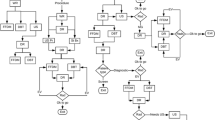Abstract
Identifying areas for workflow improvement and growth is essential for an interventional radiology (IR) department to stay competitive. Deployment of traditional methods such as Lean and Six Sigma helped in reducing the waste in workflows at a strategic level. However, achieving efficient workflow needs both strategic and tactical approaches. Uncertainties about patient arrivals, staff availability, and variability in procedure durations pose hindrances to efficient workflow and lead to delayed patient care and staff overtime. We present an alternative approach to address both tactical and strategic needs using discrete event simulation (DES) and simulation based optimization methods. A comprehensive digital model of the patient workflow in a hospital-based IR department was modeled based on expert interviews with the incumbent personnel and analysis of 192 days’ worth of electronic medical record (EMR) data. Patient arrival patterns and process times were derived from 4393 individual patient appointments. Exactly 196 unique procedures were modeled, each with its own process time distribution and rule-based procedure-room mapping. Dynamic staff schedules for interventional radiologists, technologists, and nurses were incorporated in the model. Stochastic model simulation runs revealed the resource “computed tomography (CT) suite” as the major workflow bottleneck during the morning hours. This insight compelled the radiology department leadership to re-assign time blocks on a diagnostic CT scanner to the IR group. Moreover, this approach helped identify opportunities for additional appointments at times of lower diagnostic scanner utilization. Demand for interventional service from Outpatients during late hours of the day required the facility to extend hours of operations. Simulation-based optimization methods were used to model a new staff schedule, stretching the existing pool of resources to support the additional 2.5 h of daily operation. In conclusion, this study illustrates that the combination of workflow modeling, stochastic simulations, and optimization techniques is a viable and effective approach for identifying workflow inefficiencies and discovering and validating improvement options through what-if scenario testing.









Similar content being viewed by others
References
Bleustein C, Rothschild DB, Valen A, Valatis E, Schweitzer L, Jones R: Wait times, patient satisfaction scores, and the perception of care. Am J Manag Care 20(5):393–400, 2014
Beker K, Garces-Descovich A, Mangosing J, Hallett ICGD, Mortele KJ: Optimizing MRI Logistics: Prospective Analysis of Performance, Efficiency, and Patient Throughput. AJR 209(4):836-844, 2017
Amir T, Lee B, Woods RW, Mullen LA, Harvey SC: A Pilot of Data-Driven Modeling to Assess Potential for Improved Efficiency in an Academic Breast-Imaging Center. J Digit Imaging 32:221-227, 2019
Coelli FC, Ferreira RB, Almeida RM, Pereira WC: Computer simulation and discrete-event models in the analysis of a mammography clinic patient flow. Comput Methods Programs Biomed 87(3):201-207, 2007
Berg B, Denton B, Nelson H, Balasubramanian H, Rahman A, Bailey A, Lindor K: A discrete event simulation model to evaluate operational performance of a colonoscopy suite. Med Decis Making 30(3):380–387, 2010
Saghafian S, Austin G, Traub SJ: Operations research/management contributions to emergency department patient flow optimization: Review and research prospects. IIE Trans Healthc Syst Eng 5(2):101-123, 2015
Zafar AM, Suri R, Nguyen TK, Petrash CC, Fazal Z: Understanding Preprocedure Patient Flow in IR. J Vasc Interv Radiol 27(8):1189-1194, 2016 August 2016. Volume 27, Issue 8, Pages 1189–1194.
Villarreal MC, Rostad BS, Wright R, Applegate, KE: Improving Procedure Start Times and Decreasing Delays in Interventional Radiology: A Department's Quality Improvement Initiative. Acad Radiol 22(12):1579-1586, 2015
Mason SE, Nicolay CR, Darzi A: The use of Lean and Six Sigma methodologies in surgery: A systematic review. The Surgeon. 13(2):91-100, 2015.
Siddique K, Elsayed SEA, Cheema R, Mirza S, Basu S: One-stop cholecystectomy clinic: An application of lean thinking-can it improve the outcomes? J Perioper Pract. 22 (11):360-365, 2012.
Schwarz P, Pannes KD, Nathan M, Reimer HJ, Kleespies A, Kuhn N, et al: Lean processes for optimizing OR capacity utilization: prospective analysis before and after implementation of value stream mapping (VSM). Langenbecks Arch Surg, 396(7):1047-1053, 2011.
Niemeijer GC, Flikweert E, Trip A, Does RJ, Ahaus KTB, Boot AF, et al: The usefulness of lean six sigma to the development of a clinical pathway for hip fractures. J Eval Clin Pract, 19:909-914, 2013.
Acknowledgments
The authors would like to thank Paul McGunigle, Joanie Davis, and the Lahey Hospital (Interventional Radiology) team for the invaluable insights into the workings of the department.
Author information
Authors and Affiliations
Corresponding author
Additional information
Publisher’s Note
Springer Nature remains neutral with regard to jurisdictional claims in published maps and institutional affiliations.
Rights and permissions
About this article
Cite this article
Tellis, R., Starobinets, O., Prokle, M. et al. Identifying Areas for Operational Improvement and Growth in IR Workflow Using Workflow Modeling, Simulation, and Optimization Techniques. J Digit Imaging 34, 75–84 (2021). https://doi.org/10.1007/s10278-020-00397-z
Received:
Revised:
Accepted:
Published:
Issue Date:
DOI: https://doi.org/10.1007/s10278-020-00397-z




